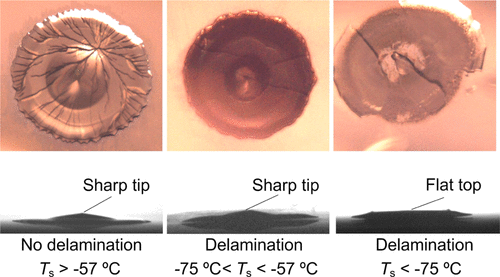Our official English website, www.x-mol.net, welcomes your feedback! (Note: you will need to create a separate account there.)
Spontaneous Deicing on Cold Surfaces.
Langmuir ( IF 3.9 ) Pub Date : 2020-09-09 , DOI: 10.1021/acs.langmuir.0c01523 Dong Song 1, 2 , Youhua Jiang 1 , Tsengming Chou 3 , Kaustubh Asawa 1 , Chang-Hwan Choi 1
Langmuir ( IF 3.9 ) Pub Date : 2020-09-09 , DOI: 10.1021/acs.langmuir.0c01523 Dong Song 1, 2 , Youhua Jiang 1 , Tsengming Chou 3 , Kaustubh Asawa 1 , Chang-Hwan Choi 1
Affiliation

|
Although freezing of a droplet on cold surfaces is a universal phenomenon, its mechanisms are still inadequately understood, especially on the surfaces of which the temperature is lower than −60 °C. Here, we report the unique spontaneous deicing phenomena of a water droplet impacting on cold surfaces with a temperature as low as −120 °C. As a hydrophilic surface is cooled below a critically low temperature (e.g., −57 °C for a silicon surface with a native oxide), the impacting water droplet spontaneously delaminates from the substrate and freezes radially outward in a horizontal plane, as opposed to the typical upward freezing shown on a warmer surface. The self-delamination phenomenon is suppressed or reinstated by the combination of thermal and hydrophobic modifications of the surface, which can be taken advantage of for effective deicing schemes for icephobic surface applications.
中文翻译:

在寒冷的表面上自发除冰。
尽管液滴在寒冷的表面上冻结是普遍现象,但其机理仍未得到充分理解,尤其是在温度低于-60°C的表面上。在这里,我们报告了水滴在低至-120°C的寒冷表面上撞击的独特自发除冰现象。当将亲水性表面冷却至临界低温以下(例如,对于具有天然氧化物的硅表面,温度为-57°C)时,与之相反,撞击的水滴自发地从基板上分层,并在水平面内径向向外冻结。典型的向上冻结显示在温暖的表面上。通过表面热和疏水改性的结合,可以抑制或恢复自分层现象,
更新日期:2020-09-29
中文翻译:

在寒冷的表面上自发除冰。
尽管液滴在寒冷的表面上冻结是普遍现象,但其机理仍未得到充分理解,尤其是在温度低于-60°C的表面上。在这里,我们报告了水滴在低至-120°C的寒冷表面上撞击的独特自发除冰现象。当将亲水性表面冷却至临界低温以下(例如,对于具有天然氧化物的硅表面,温度为-57°C)时,与之相反,撞击的水滴自发地从基板上分层,并在水平面内径向向外冻结。典型的向上冻结显示在温暖的表面上。通过表面热和疏水改性的结合,可以抑制或恢复自分层现象,


























 京公网安备 11010802027423号
京公网安备 11010802027423号